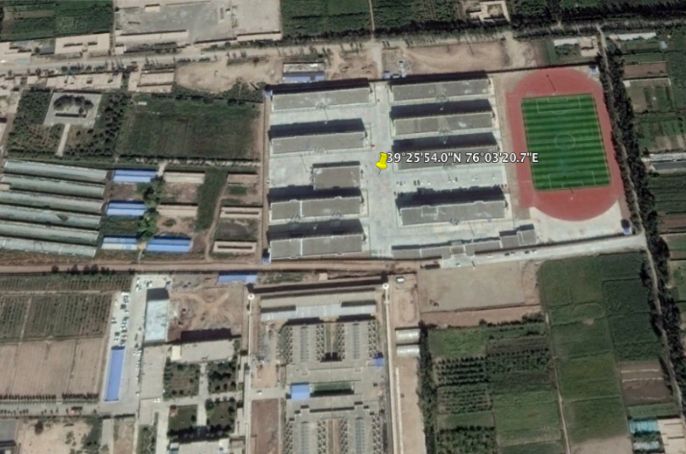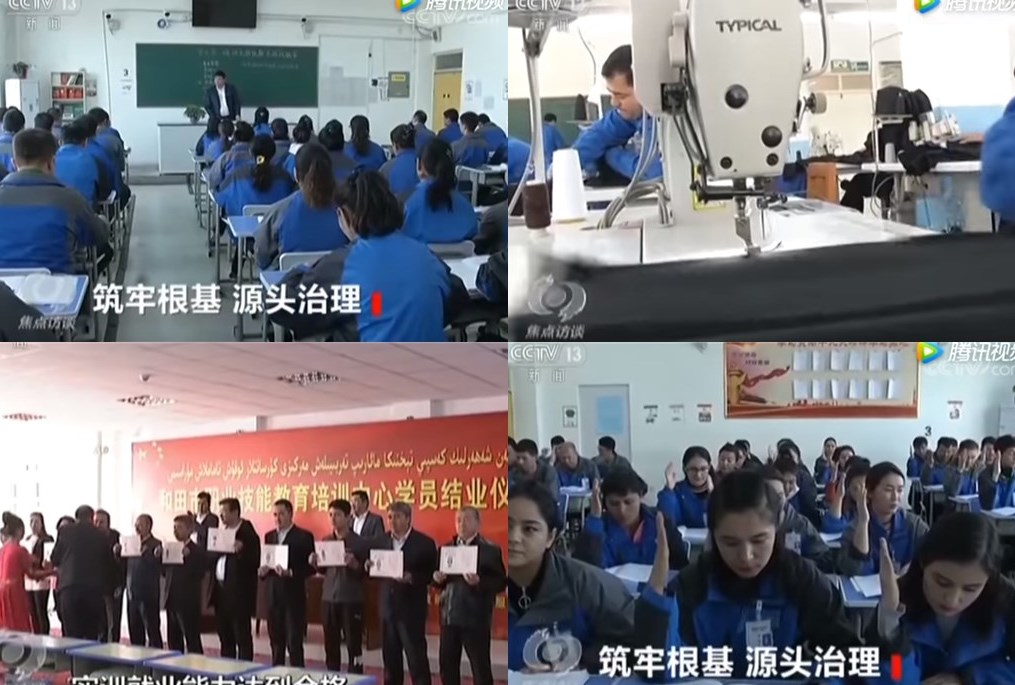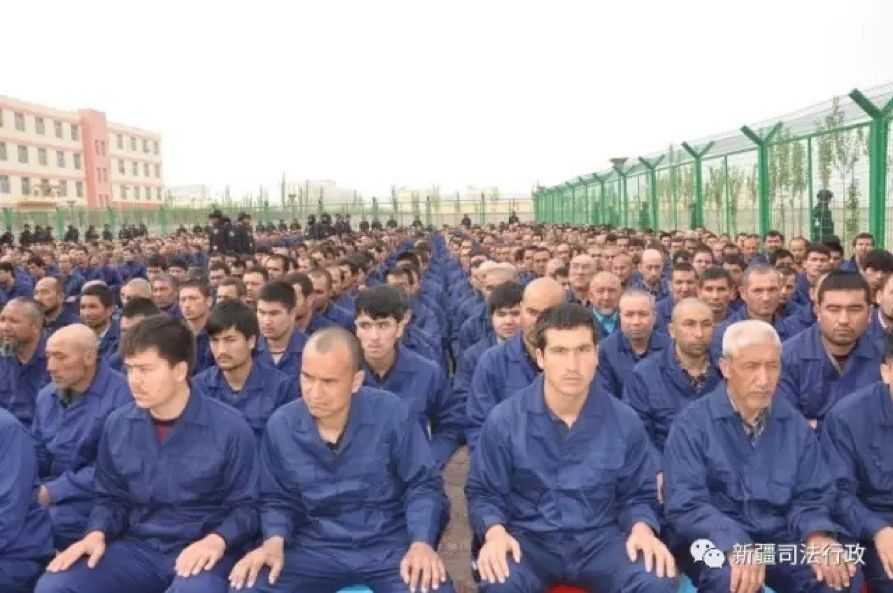8 February 2020 12:04 Guest Contributor7 min read
The World Health Organization declared the coronavirus outbreak a global public health emergency on Thursday. The Chinese government initially heavily obscured the severity of the novel coronavirus outbreak, leading to inadequate initial handling of the problem, and spread of the virus to other parts of the world.

The outbreak is now a matter of global concern, with cases confirmed in 25 countries. As of the beginning of February, there have been nearly 35,000 cases and 722 deaths.

Xinjiang “Re-education Camp” No.3, Kashgar. Photo: Google Earth.
The response from the rest of the world has been swift. Many countries have been attempting to prevent further outbreaks by evacuating nationals from China, conducting screenings at airports, restricting travel and movement of goods into and out of China, educating citizens on how to stay safe, and dispatching teams to develop vaccines and assist China with containment efforts.
However, one high-risk area has been largely ignored – Chinese occupied East Turkestan, also known as the Xinjiang Uyghur Autonomous Region of China.
The Chinese government has confirmed at least 20 cases of coronavirus in the Uyghur region, but the actual number is likely to be much higher, considering the media blackout in the region due to China’s mass detention and surveillance campaign there.
Estimates from the UN and US sources suggest China has detained more than one million and possibly as many as three million Uyghurs and other indigenous peoples in internment camps, forced labour factories and other detention facilities. Uyghurs in the diaspora fear the actual number may be much higher, especially considering the number of Uyghur children who have been separated from their families and detained in state orphanages and kindergartens.
Reports of overcrowding, malnutrition, physical and sexual abuse, organ harvesting and other grave human rights abuses in the camps suggest the region could become a breeding ground for the coronavirus. But China doesn’t seem to be allocating adequate resources to screen, diagnose and treat potential victims in East Turkestan, and has instead focused nearly all resources to combat the virus in Wuhan. Left ignored, the region could face mass outbreaks and much higher mortality rates than reported in Wuhan.
Understanding the Novel Coronavirus
The 2019 Novel Coronavirus (2019-nCoV) currently plaguing Wuhan is part of a large family of viruses that are common in many different species of animals, including camels, cattle, cats, and bats. Scientists are still analyzing the genetic tree of this virus to uncover the specific source of the infection.

The novel coronavirus under the microscope. Photo: HKU.
Two other coronaviruses known to infect humans, SARS and MERS, came from civet cats and camels, respectively. 2019-nCoV, like SARS and MERS, is transmitted via respiratory droplets produced when an infected person coughs, sneezes, drips or exhales.
Unfortunately, there is no specific recommended antiviral treatment for 2019-nCoV. Those infected need to be quarantined and treated for flu-like symptoms, such as fever, coughing, and shortness of breath. In severe cases, treatment includes care to support vital organ functions.
The best way to stay safe from the virus is to take preventative measures, including washing your hands often, wearing masks, avoiding contact with people who are sick and keeping your immune system healthy.
Coronavirus patients who are children, elderly or suffer from weak immune systems and other illnesses, are at greater risk of developing complications that may lead to death. 2019-nCoV is spreading much faster than SARS, which affected 8,000 people over eight months. Over 37,000 cases have been confirmed, but epidemiologists fear tens of thousands of more people may have been infected.
US health officials have criticized Chinese authorities for not allowing the US and other international investigative agencies to join them in researching the new virus. While China has been more transparent than it was during the 2003 SARS outbreak, US officials and other health organizations are still getting their information through press briefings rather than from direct transfer of reliable scientific data.

Chinese state media purport to show life in a Xinjiang “education centre.” Photo: CCTV screenshot.
Mortality rates are hard to estimate in the early stages of an outbreak, and the 2019-nCoV may mutate as it spreads between humans. It’s also impossible to predict whether genetic changes will make it more or less virulent. As of this week, 813 of the confirmed 2,718 cases have resulted in death. By comparison, the mortality rate of the regular seasonal flu is 1 in 1,000.
Danger of Mass Outbreaks and Deaths in the Uyghur Region
For Uyghurs and other Turkic peoples in China’s mass detention camps, access to hospitals, quarantined areas, clean and nutritious food and water, hygiene products, and necessities for healthy living are severely restricted, according to human rights monitors and camp survivors.
Detainees are held in extremely overcrowded cells where it is at times impossible to stretch without touching the person next to you. Accounts from survivors suggest many in the camps are left extremely weak from malnutrition, the terribly unhygienic conditions of the camps, and physical, mental and sexual abuse. They are therefore at a much higher risk of being infected and dying from the coronavirus.

File photo posted by the Xinjiang Judicial Administration to its WeChat account, April 2017, showing detainees at a camp in Lop county, Hotan prefecture, Xinjiang. Photo: RFA, Oct. 2, 2018; cf. WaybackMachine Internet Archive, April 17, 2017.
The coronavirus has already infected people in the region as flights and other transportation from Wuhan to Urumqi continued even after China cancelled all other flights leaving Wuhan. The Chinese government and the rest of the world has largely ignored the spread of the 2019-nCoV in the Uyghur region, and the potential for mass outbreaks and considerably higher mortality rates than in Wuhan.
Considering that each camp holds thousands of people and estimates of detentions continue to increase, the millions of Uyghur and other victims of China’s mass detention campaign may also become victims of the coronavirus.
Without external pressure, China isn’t likely to take adequate measures to address the spread of the coronavirus in East Turkestan anytime soon. Even after a massive leak of Chinese government documents that detailed China’s mass detention and surveillance campaign in East Turkestan, China continues to deny its crimes against humanity in the region.
Unable to get news about whether their family members in the camps are still alive, Uyghurs in the diaspora fear China may deliberately ignore outbreaks in the camps or use the coronavirus to explain away unrelated deaths.
The WHO and other international organizations working on global health should:
- Send delegations to East Turkestan to evaluate the current spread of the coronavirus, assess the risks inside and outside the mass detention camps, and take necessary measures to prevent mass outbreaks and mortalities.
- Work with national governments and the United Nations to pressure China to close all detention camps as part of the global response to the coronavirus outbreak.
- Send medical equipment and medical teams to screen, diagnose and treat those inside and outside of the camps in East Turkestan.

